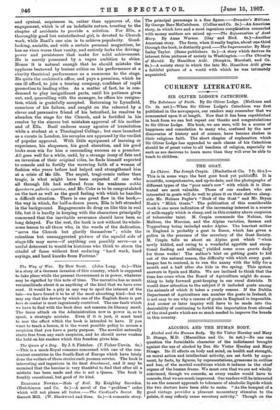THE GOAT.
La Mere. Par Joseph Crepin. (Hachette et Cie. 7 fr. 50 c.)— This is in some ways the best goat book yet publishtd. It is scientific, comprehensive, and up-to-date, and the photographs of different types of the "poor man's cow" with which it is illus- trated are most valuable. Those of our readers who are interested in goats will do well to place it on their shelves along- side Mr. Holmes Pegler's "Book of the Goat" and Mr. Bryan Hook's "Much Goats." The publication of this considerable work is one more indication of the increasing interest in a source of milk-supply which is cheap, and in this country above suspicion of tubercular taint. M. Crepin commends the Nubian, the Maltese, the Murcian, and the Alpine varieties, Saanen and Toggenburg being included under Alpine. The heaviest milker in England is probably a goat in Essex, which has given a gallon in the presence of the secretary of the Goat Society. M. Crepin tells us about an Alpine goat which "when newly kidded, and owing to a wonderful appetite and excep- tional feeding and milking," yielded some seven quarts daily for three weeks ! The author's hint on getting goats to kid out of the natural season, the difficulty with which every goat. keeper has to contend, is to run the nanny with the billy for a month and a half after she kids in the spring. This system answers in Spain and Malta. We are inclined to think that the time has come when the Board of Agriculture might do some- thing to help forward goat-keeping in our rural districts. It would draw attention to the subject if it included goats among the animals of which it takes a yearly census. If the Dublin Department of Agriculture can number the goats in Ireland, it is not easy to see why a census of goats in England is impossible. And sooner or later inquiry will have to be made into the desirability of continuing to forbid the importation from abroad of the stud goats which are so much needed to improve the breeds in this country.






































 Previous page
Previous page